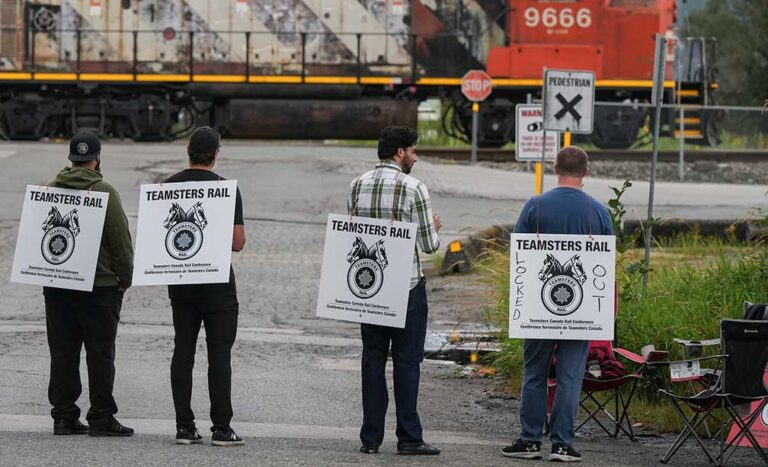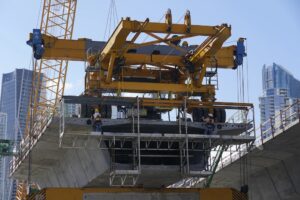TORONTO — Freight trains in Canada could be running again within days after the government forced the country’s two major railroads into arbitration with their labor union Thursday, Aug. 22, a move aimed at averting potentially dire economic consequences across Canada and in the U.S. if the trains are sidelined for a long period.
The government’s action came more than 16 hours after Canadian National (CN) and CPKC locked out workers over a labor agreement impasse. Both railroads said they would work to get trains moving again as soon as possible.
The Teamsters Canada union, representing 10,000 engineers, conductors and dispatchers, responded angrily to the order, accusing the railroads of intentionally creating a crisis to force the government to intervene. It also said it would keep its picket lines in place while reviewing the decision.
The government ordered the railroads into arbitration with the Teamsters Canada Rail Conference to end the lockout that began at 12:01 a.m. Thursday after the two sides were unable to resolve the contract dispute.
Canada’s Labor Minister Steven MacKinnon announced the decision to order the arbitration at a news conference Thursday. MacKinnon said he expects the trains will resume moving within days. Ending the lockouts is the first step.
The arbitration process was moving quickly, with the railroads meeting with the Canada Industrial Relations Board on Thursday night, according to a person familiar with the schedule who spoke on condition of anonymity because they weren’t authorized to discuss it. The Teamsters confirmed that the union was also meeting with the board Thursday night.
Throughout the day Thursday, both sides negotiated unsuccessfully while workers picketed outside and business groups urged the government to force the arbitration.
Teamsters Canada Rail Conference President Paul Boucher criticized the government’s decision to step in so soon.
“The two major railways in Canada manufactured this crisis, took the country hostage, and manipulated the government to once again disregard the rights afforded to working-class Canadians,” Boucher said. “The Teamsters Canada Rail Conference (TCRC) is deeply disappointed by this shameful decision.”
The railroad companies hailed the decision, saying the government had no choice.
“The Canadian government has recognized the immense consequences of a railway work stoppage for the Canadian economy, North American supply chains and all Canadians,” said Keith Creel, CPKC’s president and CEO. “The government has acted to protect Canada’s national interest. We regret that the government had to intervene because we fundamentally believe in and respect collective bargaining; however, given the stakes for all involved, this situation required action.”
Lockout poses risk to supply chain, economy
MacKinnon said the government wanted to give negotiations every chance to succeed, but ultimately the economic risk was too great to allow the lockouts to continue. He had declined to order arbitration a week ago.
“Canada’s economy cannot wait for an agreement that has been delayed for a very long time and when there is a fundamental disagreement between the parties,” he said.
All of Canada’s freight handled by rail — worth more than $1 billion Canadian (US$730 million) a day and adding up to more than 375 million tons of freight last year — stopped Thursday along with rail shipments crossing the U.S. border. About 30,000 commuters in Canada were also affected because their trains use CPKC’s lines. CPKC and CN’s trains continued operating in the U.S. and Mexico during the lockout.
Many companies in both countries and across all industries rely on railroads to deliver their raw materials and finished products, so they were concerned about a crisis without regular rail service. Billions of dollars of goods move between Canada and the U.S. via rail each month, according to the U.S. Department of Transportation.
Trudeau decided not to force the parties into binding arbitration before the deadline passed for fear of offending unions and the leftist NDP party that his government relies on for support to remain in power, but he ultimately decided he didn’t have a choice.
“Collective bargaining is always the best way forward. When that is no longer a foreseeable option — when we are facing serious consequences to our supply chains and the workers who depend on it — governments must act,” Trudeau said.
Impact on supply chain, commuters
Most businesses probably have enough supplies on hand and room to store finished products to withstand a brief disruption. But ports and other railroads would have quickly become clogged with stranded shipments that CN and CPKC won’t pick up.
Many companies made supply chain changes after the COVID-19 pandemic that can help them withstand a short disruption, said Edward Jones analyst Jeff Windau. The real trouble starts if it drags on, he said.
Most previous Canadian rail stoppages have only lasted a day or two and usually involved only one of the big railroads, but some have stretched as long as eight or nine days. The impact was magnified this time because both railroads had stopped.
“They are so integrated and tied into the economy,” Windau said. “Just the breadth of products that they haul. … Ultimately, I think we need the rails to continue to be running.”
Chemical businesses and food distributors would have been the first to be affected. The railroads stopped accepting new shipments of hazardous materials and perishable goods as they began gradually shutting down last week, but most chemical plants had said they would be OK for about a week.
The auto industry also may have seen problems quickly because it relies on just-in-time shipments, with significant cross-border deliveries of engines, parts and finished vehicles. Flavio Volpe, President of the Automotive Parts Manufacturers’ Association, posted on X that about four of every five cars made in Canada are exported to the U.S. almost exclusively by rail. He said a prolonged lockout could cause temporary work stoppages similar to the impact of the five-day 2022 Ambassador Bridge blockade.
More than 30,000 commuters in Vancouver, Toronto and Montreal were the first to feel the pain of the lockouts and they may be stuck taking the bus again Friday. Their commuter trains are unable to operate while CPKC dispatchers are locked out.
CN had been negotiating with the Teamsters for nine months while CPKC had been trying to reach an agreement for a year, the union said.
Sticking points
The Canadian negotiations are stuck on issues related to the way rail workers are scheduled and concerns about rules designed to prevent fatigue and provide adequate rest to train crews. Both railroads had proposed shifting away from the existing system, which pays workers based on the miles in a trip, to an hourly system that they said would make it easier to provide predictable time off. The union said it doesn’t want to lose hard-fought fatigue protections.
The railroads said their contract offers have included raises consistent with recent deals in the industry. Engineers already make about $150,000 a year on Canadian National while conductors earn $120,000, and CPKC says its wages are comparable.
By Rob Gillies and Josh Funk, The Associated Press. Funk reported from Omaha, Nebraska. Associated Press writer Aamer Madhani in Buellton, California, contributed to this report.
The Associated Press is an independent global news organization dedicated to factual reporting. Founded in 1846, AP today remains the most trusted source of fast, accurate, unbiased news in all formats and the essential provider of the technology and services vital to the news business. The Trucker Media Group is subscriber of The Associated Press has been granted the license to use this content on TheTrucker.com and The Trucker newspaper in accordance with its Content License Agreement with The Associated Press.






